Abstract
BACKGROUND: Antisense represents a conceptually powerful method for regulating gene expression. However, antisense oligonucleotides developed to date manifest two serious limitations-nuclease susceptibility and nonspecific hybridization. Circular oligonucleotides may be superior to conventional linear oligonucleotides in both respects. First, circular agents, having no ends, are exonuclease-resistant. Second, they bind to complementary strands of RNA and DNA with a higher affinity than corresponding linear agents. METHODS AND RESULTS: We assessed the activity of circular phosphodiester deoxynucleotides using chronic myeloid cell lines by targeting polypurine sequences. To represent cells having a bcr3/abl2-type junction, we used K562 cells. A circle targeting a bcr polypurine sequence 385 nucleotides 5' to the junction decreased the cell number by day 5 with an IC(50) of 9 microM. To represent cells having a bcr2/abl2-type junction, we used BV173 cells. A circle targeting the bcr-abl junction itself decreased the cell number by day 7 with an IC(50) of 8 microM. Control oligonucleotides, whether the same sequence uncircularized or circles with the same nucleotide composition but in scrambled sequence, had little effect. Unlike linear agents, circles were stable when incubated in 10% serum. The amount of bcr-abl protein detected by Western blotting using a specific anti-bcr-abl antibody at 24 hr in antisense-treated BV173 cells was only 10% of that of cells treated with control circles, which demonstrates an antisense mechanism of action. CONCLUSIONS: Circular oligodeoxyribonucleotides (1) inhibit the accumulation of CML cells, (2) decrease the amount of bcr-abl protein per cell, (3) have sequence-selective activity, and (4) are more active than linear oligonucleotides containing only the base-pairing region.
Full text
PDF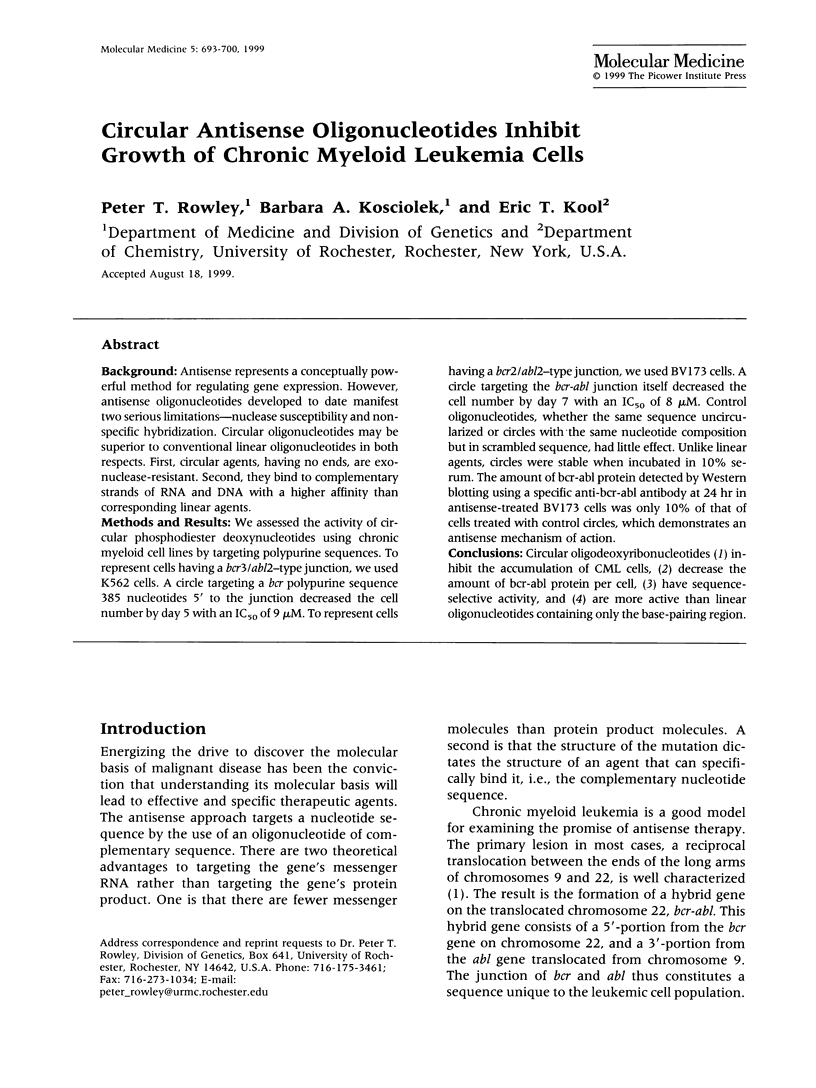
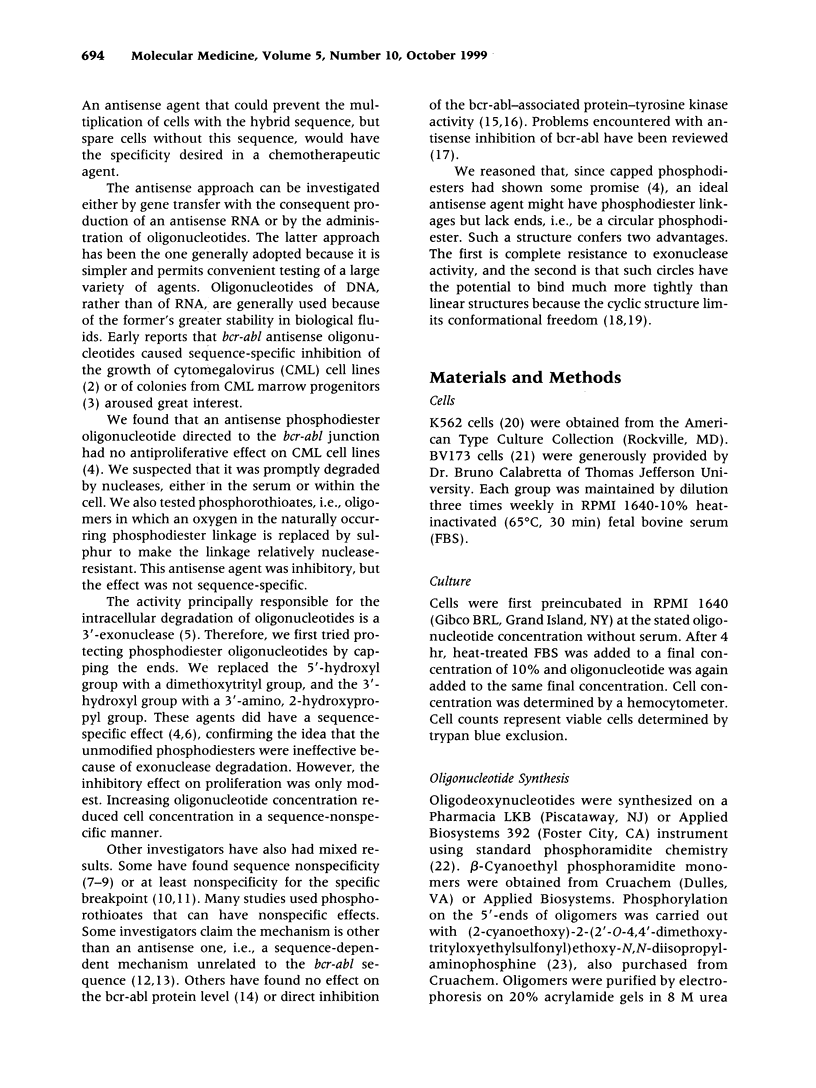
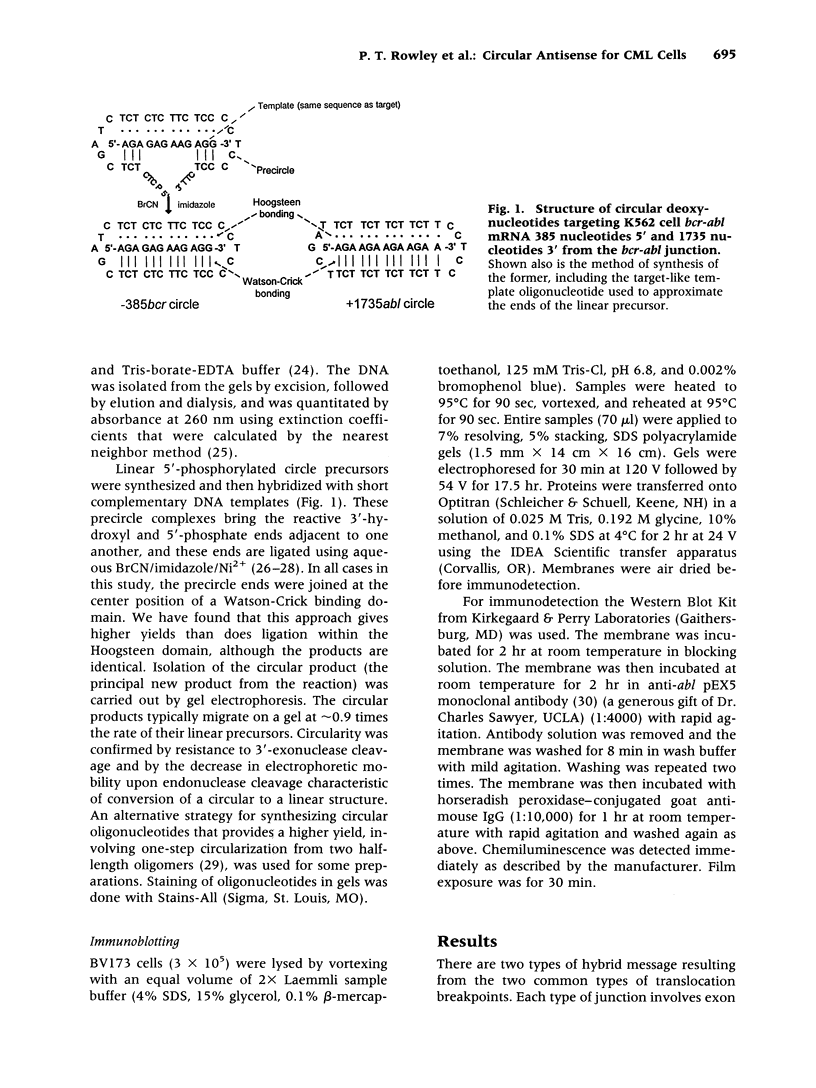
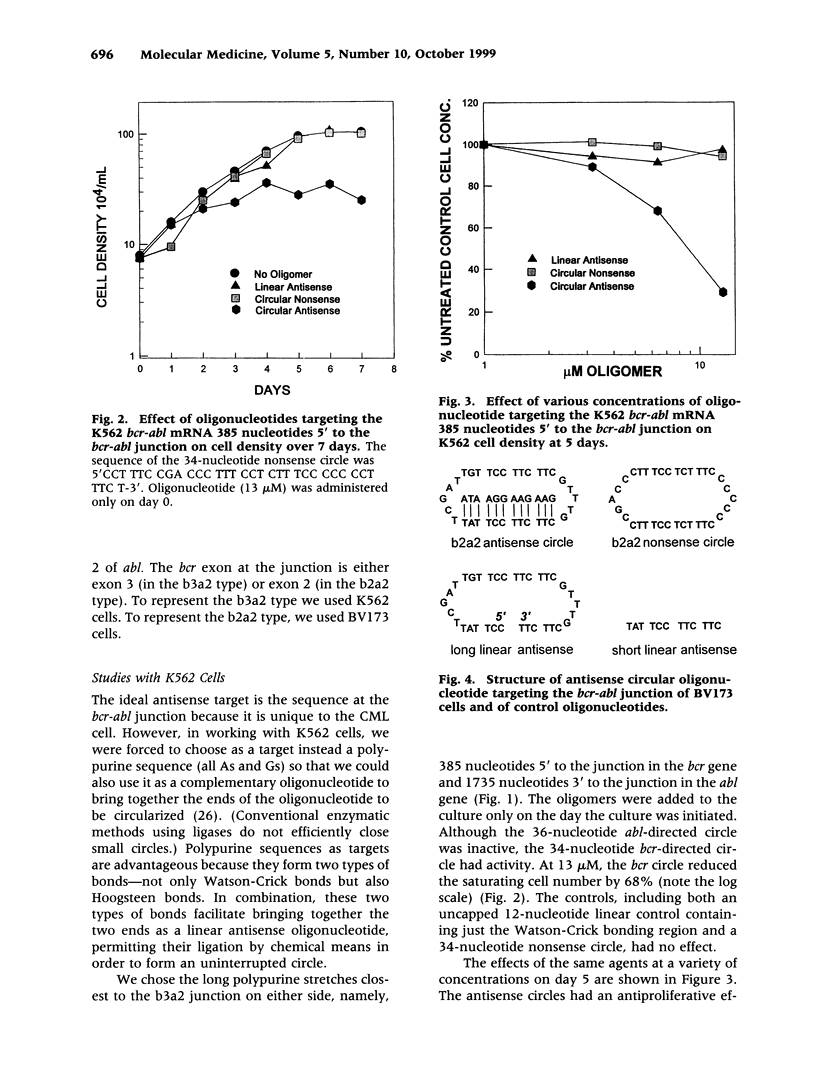
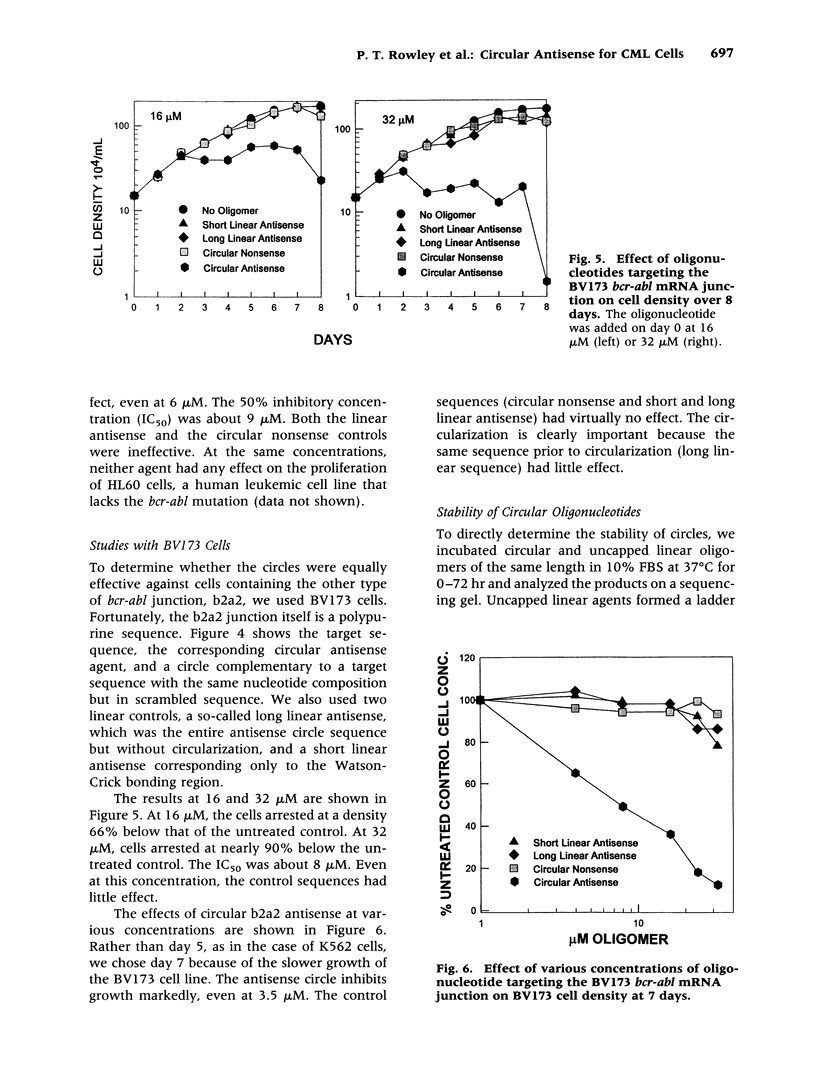
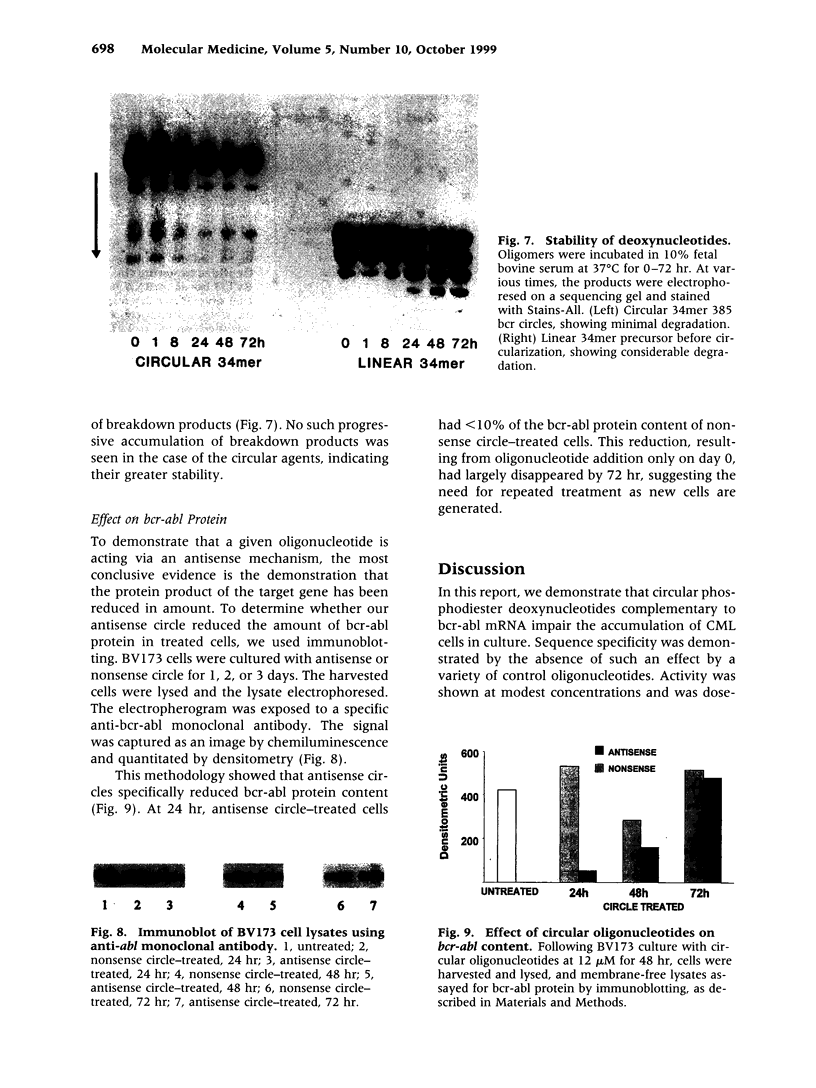
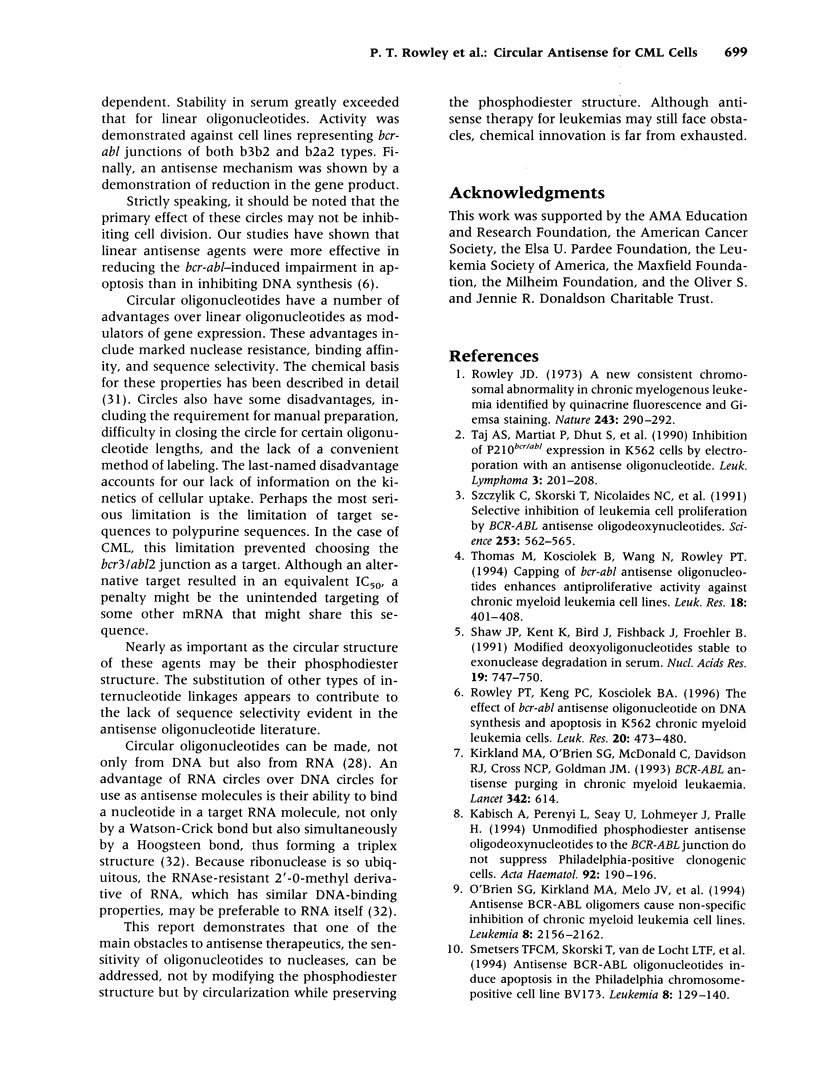
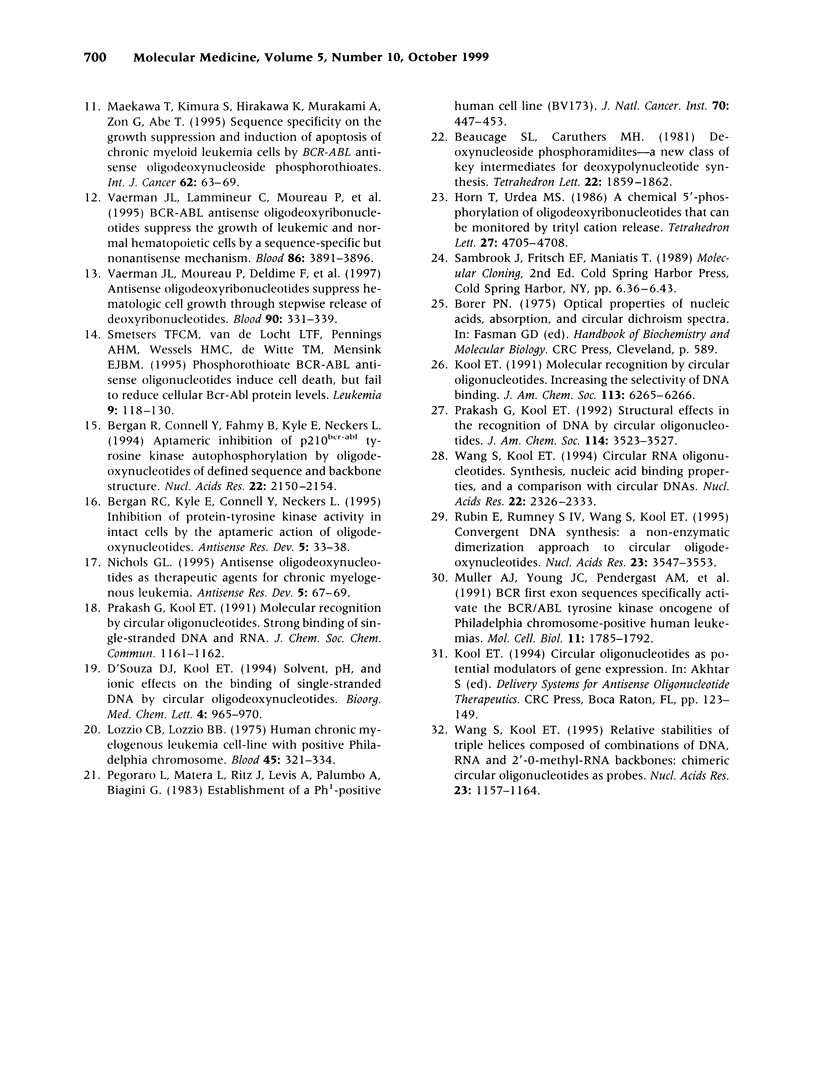
Images in this article
Selected References
These references are in PubMed. This may not be the complete list of references from this article.
- Bergan R. C., Kyle E., Connell Y., Neckers L. Inhibition of protein-tyrosine kinase activity in intact cells by the aptameric action of oligodeoxynucleotides. Antisense Res Dev. 1995 Spring;5(1):33–38. doi: 10.1089/ard.1995.5.33. [DOI] [PubMed] [Google Scholar]
- Bergan R., Connell Y., Fahmy B., Kyle E., Neckers L. Aptameric inhibition of p210bcr-abl tyrosine kinase autophosphorylation by oligodeoxynucleotides of defined sequence and backbone structure. Nucleic Acids Res. 1994 Jun 11;22(11):2150–2154. doi: 10.1093/nar/22.11.2150. [DOI] [PMC free article] [PubMed] [Google Scholar]
- Kirkland M. A., O'Brien S. G., McDonald C., Davidson R. J., Cross N. C., Goldman J. M. BCR-ABL antisense purging in chronic myeloid leukaemia. Lancet. 1993 Sep 4;342(8871):614–614. doi: 10.1016/0140-6736(93)91438-r. [DOI] [PubMed] [Google Scholar]
- Käbisch A., Pérènyi L., Seay U., Lohmeyer J., Pralle H. Unmodified phosphodiester antisense oligodeoxynucleotides to the BCR-ABL junction do not suppress Philadelphia-positive clonogenic cells. Acta Haematol. 1994;92(4):190–196. doi: 10.1159/000204219. [DOI] [PubMed] [Google Scholar]
- Lozzio C. B., Lozzio B. B. Human chronic myelogenous leukemia cell-line with positive Philadelphia chromosome. Blood. 1975 Mar;45(3):321–334. [PubMed] [Google Scholar]
- Maekawa T., Kimura S., Hirakawa K., Murakami A., Zon G., Abe T. Sequence specificity on the growth suppression and induction of apoptosis of chronic myeloid leukemia cells by BCR-ABL anti-sense oligodeoxynucleoside phosphorothioates. Int J Cancer. 1995 Jul 4;62(1):63–69. doi: 10.1002/ijc.2910620113. [DOI] [PubMed] [Google Scholar]
- Muller A. J., Young J. C., Pendergast A. M., Pondel M., Landau N. R., Littman D. R., Witte O. N. BCR first exon sequences specifically activate the BCR/ABL tyrosine kinase oncogene of Philadelphia chromosome-positive human leukemias. Mol Cell Biol. 1991 Apr;11(4):1785–1792. doi: 10.1128/mcb.11.4.1785. [DOI] [PMC free article] [PubMed] [Google Scholar]
- Nichols G. L. Antisense oligodeoxynucleotides as therapeutic agents for chronic myelogenous leukemia. Antisense Res Dev. 1995 Spring;5(1):67–69. doi: 10.1089/ard.1995.5.67. [DOI] [PubMed] [Google Scholar]
- O'Brien S. G., Kirkland M. A., Melo J. V., Rao M. H., Davidson R. J., McDonald C., Goldman J. M. Antisense BCR-ABL oligomers cause non-specific inhibition of chronic myeloid leukemia cell lines. Leukemia. 1994 Dec;8(12):2156–2162. [PubMed] [Google Scholar]
- Pegoraro L., Matera L., Ritz J., Levis A., Palumbo A., Biagini G. Establishment of a Ph1-positive human cell line (BV173). J Natl Cancer Inst. 1983 Mar;70(3):447–453. [PubMed] [Google Scholar]
- Rowley J. D. Letter: A new consistent chromosomal abnormality in chronic myelogenous leukaemia identified by quinacrine fluorescence and Giemsa staining. Nature. 1973 Jun 1;243(5405):290–293. doi: 10.1038/243290a0. [DOI] [PubMed] [Google Scholar]
- Rowley P. T., Keng P. C., Kosciolek B. A. The effect of bcr-abl antisense oligonucleotide on DNA synthesis and apoptosis in K562 chronic myeloid leukemia cells. Leuk Res. 1996 Jun;20(6):473–480. doi: 10.1016/0145-2126(95)00172-7. [DOI] [PubMed] [Google Scholar]
- Rubin E., Rumney S., 4th, Wang S., Kool E. T. Convergent DNA synthesis: a non-enzymatic dimerization approach to circular oligodeoxynucleotides. Nucleic Acids Res. 1995 Sep 11;23(17):3547–3553. doi: 10.1093/nar/23.17.3547. [DOI] [PMC free article] [PubMed] [Google Scholar]
- Shaw J. P., Kent K., Bird J., Fishback J., Froehler B. Modified deoxyoligonucleotides stable to exonuclease degradation in serum. Nucleic Acids Res. 1991 Feb 25;19(4):747–750. doi: 10.1093/nar/19.4.747. [DOI] [PMC free article] [PubMed] [Google Scholar]
- Smetsers T. F., Skorski T., van de Locht L. T., Wessels H. M., Pennings A. H., de Witte T., Calabretta B., Mensink E. J. Antisense BCR-ABL oligonucleotides induce apoptosis in the Philadelphia chromosome-positive cell line BV173. Leukemia. 1994 Jan;8(1):129–140. [PubMed] [Google Scholar]
- Smetsers T. F., van de Locht L. T., Pennings A. H., Wessels H. M., de Witte T. M., Mensink E. J. Phosphorothioate BCR-ABL antisense oligonucleotides induce cell death, but fail to reduce cellular bcr-abl protein levels. Leukemia. 1995 Jan;9(1):118–130. [PubMed] [Google Scholar]
- Szczylik C., Skorski T., Nicolaides N. C., Manzella L., Malaguarnera L., Venturelli D., Gewirtz A. M., Calabretta B. Selective inhibition of leukemia cell proliferation by BCR-ABL antisense oligodeoxynucleotides. Science. 1991 Aug 2;253(5019):562–565. doi: 10.1126/science.1857987. [DOI] [PubMed] [Google Scholar]
- Thomas M., Kosciolek B., Wang N., Rowley P. Capping of bcr-abl antisense oligonucleotides enhances antiproliferative activity against chronic myeloid leukemia cell lines. Leuk Res. 1994 Jun;18(6):401–408. doi: 10.1016/0145-2126(94)90075-2. [DOI] [PubMed] [Google Scholar]
- Vaerman J. L., Lammineur C., Moureau P., Lewalle P., Deldime F., Blumenfeld M., Martiat P. BCR-ABL antisense oligodeoxyribonucleotides suppress the growth of leukemic and normal hematopoietic cells by a sequence-specific but nonantisense mechanism. Blood. 1995 Nov 15;86(10):3891–3896. [PubMed] [Google Scholar]
- Vaerman J. L., Moureau P., Deldime F., Lewalle P., Lammineur C., Morschhauser F., Martiat P. Antisense oligodeoxyribonucleotides suppress hematologic cell growth through stepwise release of deoxyribonucleotides. Blood. 1997 Jul 1;90(1):331–339. [PubMed] [Google Scholar]
- Wang S., Kool E. T. Circular RNA oligonucleotides. Synthesis, nucleic acid binding properties, and a comparison with circular DNAs. Nucleic Acids Res. 1994 Jun 25;22(12):2326–2333. doi: 10.1093/nar/22.12.2326. [DOI] [PMC free article] [PubMed] [Google Scholar]
- Wang S., Kool E. T. Relative stabilities of triple helices composed of combinations of DNA, RNA and 2'-O-methyl-RNA backbones: chimeric circular oligonucleotides as probes. Nucleic Acids Res. 1995 Apr 11;23(7):1157–1164. doi: 10.1093/nar/23.7.1157. [DOI] [PMC free article] [PubMed] [Google Scholar]





